Alpine Valley is tucked away off the interstate in southeast Wisconsin. Most of the state, flattened out by glaciers during the last ice age, is plains and farm fields, but around East Troy — near Alpine Valley, at the edge of the Kettle Moraine region — are green, rolling hills. The road, which dives into a valley through a clump of trees, rushes down and then back uphill before the entrance to the grounds, which lie at the foot of a ski hill. And there, somewhere back behind the wooded hills — 1,000 miles away from Texas — is where Stevie Ray Vaughan died.
Most of the year, the 37,000-person amphitheater plays host to shows that are too big for Milwaukee, sometimes even too big for Chicago. Bands like Pearl Jam, Dave Matthews Band and Phish bring in fans from around the upper Midwest. It's the midpoint of the drive from my hometown in south central Wisconsin to Milwaukee (where my parents grew up). I've been past Alpine Valley thousands of times, and even went to my very first concert there, Tom Petty, but it will always be known as the place where Vaughan was whisked away from the world.
Twenty-five years ago last week, Vaughan played his last concert, a show that likely would have gone down in local legend on its own merit — a star-studded blues jam that included Eric Clapton, Robert Cray, Buddy Guy and Vaughan's older brother Jimmie. Lost in the fog that night, the helicopter Vaughan was riding in crashed into a ski slope at the nearby resort. My parents, who never saw Vaughan play live, remain huge fans to this day, collecting his CDs, DVDs, box sets and biographies. I was 3 when Vaughan died, but my earliest memory of his music is hearing it in our family's living room, while my parents explained that this Texas bluesman was "gone too soon" — robbed of showing the world what he was really capable of.
Vaughan's music manages to hold that same power for many of his fans today. Earlier this year, those fans received some long-sought reward when the Dallas native was inducted into the Rock 'N' Roll Hall of Fame — an honor many felt had been overdue. And now, seemingly just as overdue if not more, movements are afoot to bring a proper memorial to Vaughan and his brother here in Dallas, where they were born and cut their teeth in the 1970s. Tonight, The Kessler Theater holds a fundraiser to help make that memorial a reality.
For local blues musician Charley Crockett, who was born in South Texas and raised in Dallas and New Orleans, the thought of a memorial for Vaughan is an exciting proposition. "His influence is massive. It's a tragedy we lost him early. He was really at his height," says Crockett. He was at his best. He'd kicked his habits and proved you could play better that way as you're getting older."
Crockett's music, a mix of New Orleans and Delta blues with folk and R&B influences, isn't outwardly similar to Vaughan's, but he sees a kindred spirit in the late guitarist, who he calls "the real thing." "You couldn't be a suburban person learning in your room. You had to get out in these blues rooms," he says. And while Vaughan spent a portion of his adult life in Austin, Crockett sees him as a crucial figure to Dallas blues. "He had to go to Austin because it had a way bigger live blues scene," he admits. "But he lived in Dallas when he died. He lived on Travis."
It's a sentiment shared by Brett Strawn, the guitarist for local noise-punks Party Static, a band seemingly a world removed from Vaughan's music. "He had a huge impact in Dallas and probably around the world," Strawn says. "I have a lot of respect for him and his talent." While Strawn has predominantly played in punk and indie bands over the years, he learned guitar by playing the blues. "When I first started playing guitar, my instructor was a huge Stevie Ray Vaughan fan, so I learned a lot of his stuff," he remembers. "I think it's actually really important for someone learning guitar to learn the blues. It teaches you a lot about how to improvise."
One of Vaughan's endearing legacies was his role as a gateway for many musicians and music fans into the blues. At a time when punk and hip-hop had cast the blues into seeming obsolescence, Vaughan's flamboyance and soulful style (helped by the rich tones of heavy gauge strings) gave the music a new lease on life in the mid-1980s. "He was such a showman. He's the first person I know of, or that I remember hearing about, who played behind his head and all of that kind of stuff," says Strawn.
In his later years, too, Vaughan, known to many for his guitar heroics, showed his full versatility, mixing in more funk and R&B, particularly on his final studio album, In Step. "He did have a lot of crossover appeal," Strawn says. "He was on records with David Bowie. That's a really big deal. There are probably a lot of people who like songs he's on and don't even consider themselves to be fans."
In some ways, that crossover appeal has perhaps hurt Vaughan in the long run. Strawn admits that he doesn't really listen to Vaughan's music these days — "It's not exactly edgy, I guess," he says — but even more important may be the effects of some of those who have copied him since his death. "There are so many people trying to imitate Stevie Ray Vaughan without really recognizing what he himself was really about, which was trying to direct people toward the really great players that moved him," Crockett says. "I could be wrong, but you got John Mayer and all these people who are really huge Stevie Ray Vaughan fans for sure, but I think for him he'd have a hard time with that kind of worship."
For all of Vaughan's skills as a guitarist and flair as a performer, Crockett identifies most with him because of his deep appreciation for the blues and his ability to serve as an ambassador for it. "He was mixed Native American and was a really spiritual, deep person," Crockett points out. "I don't think anybody has the blues more than Native Americans. They're not generally considered a part of the population." While earlier white blues players were guilty of generously lifting ideas and even whole songs from obscure African American musicians, Vaughan not only learned the music from veteran players but made a point of bringing them onstage even after he'd gotten famous. "There's a huge list of incredible black players from Deep Ellum you never hear about," says Crockett. "There are no statues for them, no museums where we could go and really see the depth of that heritage. I feel really confident that wouldn't have been the case if Stevie Ray Vaughan were alive."
But then that may be the rub of Vaughan's potentially being honored by his home city, as far as Crockett is concerned. "It's like, yeah, let's get that Stevie Ray Vaughan statue up," Crockett says. "But I bet you he'd be like, 'Alright, you want to get my statue up but don't you think maybe we should have a Robert Johnson statue or T-Bone Walker or Blind Lemon Jefferson?' He'd want theirs to go up first ...That's how he was."
THE VAUGHAN BROTHERS ART PROJECT FUNDRAISER CONCERT with Smokin' Joe Kubek, Jim Suhler and Carolyn Wonderland, 7:30 p.m. Thursday, September 3, at The Kessler Theater, 1230 W. Davis St., $75
[
{
"name": "Air - MediumRectangle - Inline Content - Mobile Display Size",
"component": "18855504",
"insertPoint": "2",
"requiredCountToDisplay": "2"
},{
"name": "Editor Picks",
"component": "17105533",
"insertPoint": "4",
"requiredCountToDisplay": "1"
},{
"name": "Inline Links",
"component": "18349797",
"insertPoint": "8th",
"startingPoint": 8,
"requiredCountToDisplay": "7",
"maxInsertions": 25
},{
"name": "Air - MediumRectangle - Combo - Inline Content",
"component": "17105532",
"insertPoint": "8th",
"startingPoint": 8,
"requiredCountToDisplay": "7",
"maxInsertions": 25
},{
"name": "Inline Links",
"component": "18349797",
"insertPoint": "8th",
"startingPoint": 12,
"requiredCountToDisplay": "11",
"maxInsertions": 25
},{
"name": "Air - Leaderboard Tower - Combo - Inline Content",
"component": "17105535",
"insertPoint": "8th",
"startingPoint": 12,
"requiredCountToDisplay": "11",
"maxInsertions": 25
}
]











